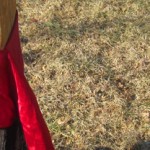I like to think I’ve grown wiser over the years. It would be a sad commentary on my life if that was not the case. And I’m ready to admit I’ve been downright wrong about many things, especially when it comes to art and style. I’m not just talking about the parachute pants I wore in the eighties (although they definitely fit into this category).
Music has played a huge role in my life. My first white-collar job was at radio station WADV, a Southern Gospel and Christian Country station. The Southern Gospel had its moments, but I took to the Christian Country artists. The Mid South Boys, Paul Overstreet, Bruce Carroll—there weren’t many. Then it was off to college where I was introduced to many more genres.
I sought out music that had something of value to say and I discovered a series of bands that were doing some amazingly creative things. And these bands were giving honor to God, although in a less direct way than I was used to. Most songs made no mention of God. Some referred to God or to the teachings of the Bible indirectly. And occasionally, God’s name was actually mentioned. I took to this—and so did a whole subculture of young men (and a few ladies) just like me. We gathered and shared our thoughts in a group setting through an interface that was novel at the time: the internet.
But with my admiration for the artistic expression of these artists came a deep snobbery. This community praised the obscure poetry and creative musicianship as “true art” while the artist who sang directly of their love for Christ was actually considered harmful. I’d like to think that’s because there were simply no good examples at the time, but of course that’s not true. And I remember no exceptions granted. I’m not saying this group didn’t have some very valid points. They did. But here is where I feel things crossed the line.
Let’s jump to a parallel track.
Someone looks at an abstract painting and says “I could do that.” And the common response is “Yeah, but you didn’t.” That viewer may find creating an abstract piece of artwork is much more difficult than it appears. As someone who claims to be an artist, I speak from experience. I’ve imagined myself filling large canvases with bold, lively, colorful brush strokes. But when I would sit in front of the blank canvas, I freeze. It’s then I see confirmation that abstract art does begin with a concept. And even if that concept is clear in the mind, execution requires ability beyond the desire.
But when it comes to revealing one’s artwork to the world, the abstract artist has an advantage. For who can claim him to be right or wrong? The artwork can still be judged according to balance, movement, harmony, and other elements of design. But it’s usually the trained eye that is consciously using these criteria. The abstract artist has a loophole around criticism, especially when offering a single work as opposed to a series. To what standard should it be compared?
Compare this to visual works of realism (or naturalism). The viewer has seen thousands of faces. If the artist’s rendition of a face is slightly off, it will be glaringly apparent. The viewer will notice if the horizon is unnatural, if the tree is elongated, if the reflection is not true.
In abstraction, it is much easier to disguise the fact that your artwork is not hitting the mark. It becomes easy to look down on the naturalistic artist who is struggling to hit their mark. Their failure is obvious. And seeing too much of this can lead a person to put down the genre.
The painter or sculptor of realistic works—just like the songwriter who sings directly of God and His character—has accepted a difficult task. The artist is giving viewers an alternative to a photograph and, really, to simply looking at nature and the world around them. The songwriter is giving listeners an alternative to simply reading Scripture. How can they compete? How can they succeed?
The triumphs I’ve seen emerge are from the ones who bring a piece of themselves to their art. Realism does not preclude creativity. But this is a subject beyond the scope of the topic at hand.
The point is that the abstract artist needs a healthy respect for the realistic artist. For the path to their success is steep, and their successes loom large. Similarly, the songwriter who hides meaning behind layers of poetry need not look down on those who clearly sing the purpose of the song. For when they succeed, they stand the test of time. They are like the great monuments—the simple, straightforward, elegant solutions that connect with the heart. They continue to inspire, and they remain relevant across the decades.
The struggle comes in the reality that many “realistic” songs and paintings do fail. And I want to be fair to the abstract artists—their successes can be just as difficult. However, the depth of their shortcomings are known mainly to them. I’ve found artists of abstraction end up with a consistently good body of work, while the artists of realism have more ups and downs. But the peaks they reach when they are up are truly great.



